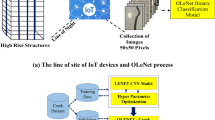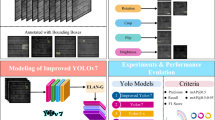Abstract
Renewable energy resources are the only solution to the energy crisis over the world. Production of energy by the solar panel cells are identified as the main renewable energy resources. The generation of energy by the solar panels is affected by the cracks on it. Hence, the detection of cracks is important to increase the energy levels produced by the solar cells. In this paper, the solar panel images are classified into either cracked image or non-cracked image using deep learning algorithm. The proposed method is designed with the following modules preprocessing, enhancement, feature computations, classification and crack segmentation. The source solar panel image are denoised using adaptive median filter as the preprocessing process and then the pixels in denoised solar panel image are enhanced using cumulative enhancement (CE) method. The external features are computed from the CE enhanced solar panel image and these features are classified by Improved AlexNet (IAN)-deep learning classifier to produce the classification results as either cracked or non-cracked solar panel image. Finally, the cracks in classified cracked solar panel image are segmented using morphological algorithm. The main significance of this paper is that the proposed methods stated here detect single and multiple level of minor cracks, which enhances the energy levels production.








Similar content being viewed by others
REFERENCES
Khatir, S., Dekemele, K., and Loccufier, M., Crack identification method in beam-like structures using changes in experimentally measured frequencies and particle swarm optimization, Comptes Rendus Mécanique, 2018, vol. 346, pp. 110–120.
Hopkins, P.F., Anisotropic diffusion in mesh-free numerical magnetohydrodynamics, Mon. Not. R. Astron. Soc., 2017, vol. 466, pp. 3387–3405.
Haase, F., Käsewieter, J., Nabavi, S.R., Jansen, E., Rolfes, R., and Köntges, M., Fracture probability, crack patterns, and crack widths of multicrystalline silicon solar cells in PV modules during mechanical loading, IEEE J. Photovolt., 2018, vol. 8, pp. 1510–1524.
Stromer, D., Vetter, A., Oezkan, H.C., Probst, C., and Maier, A., Enhanced crack segmentation (eCS): A reference algorithm for segmenting cracks in multi-crystalline silicon solar cells, IEEE J. Photovolt., 2019, vol. 9, pp. 752–758.
Bhoopathy, R., Kunz, O., Juhl, M., Trupke, T., and Hameiri, Z., Outdoor photoluminescence imaging of photovoltaic modules with sunlight excitation, Prog. Photovolt. Res. Appl., 2018, vol. 26, pp. 69–73.
Chen, H., Zhao, H., Han, D., and Liu, K., Accurate and robust crack detection using steerableevidence filtering in electroluminescence images of solar cells, Optics Lasers Eng., 2019, vol. 118, pp. 22–33.
Shi, Y., Cui, L., Qi, Z., Meng, F., and Chen, Z., Automatic road crack detection using random structured forests, IEEE Trans. Intell. Transp. Syst., 2016, vol. 17, no. 12, pp. 3434–3445.
Frazao, M., Silva, J.A., Lobato, K., and Serra, J.M., Electroluminescence of silicon solar cells using a consumer grade digital camera, Measurement, 2017, vol. 99, pp. 7–12.
Han, X., Zhong, Y., Cao, L., and Zhang, L., Pre-trained AlexNet architecture with pyramid pooling and supervision for high spatial resolution remote sensing image scene classification, Remote Sens., 2017, vol. 9, p. 848.
Ha, R., Liu, P., and Jia, K., An improved adaptive median filter algorithm and its application, In: Advances in Intelligent Information Hiding and Multimedia Signal Processing. Smart Innovation, Systems and Technologies, Pan, J.S., Tsai, P.W., Huang, H.C., Eds., Berlin: Springer, 2017, p. 64.
Fan, T., Sun, T., Xie, X., Liu, H., and Na, Z., Automatic micro-crack detection of polycrystalline solar cells in industrial scene, IEEE Access, 2022, vol. 10, pp. 16269–16282.
Xue, B., Li, F., Song, M., Shang, X., and Cui, D., Crack extraction for polycrystalline solar panels, Energies, 2021, vol. 14, no. 374, pp. 1–18.
Greulich, J.M., et al., Comparison of inline crack detection systems for multicrystalline silicon solar cells, IEEE J. Photovolt., 2020, vol. 10, no. 5, pp. 1389–1395.
Dhimish, M. and Holmes, V., Solar cells micro crack detection technique using state-of-the-art electroluminescence imaging, J. Sci. Adv. Mater. Devices, 2019, vol. 4, pp. 499–508.
Akash, S.C. and Chaturvedi, D.K., Analyzing defects of solar panels under natural atmospheric conditions with thermal image processing, Int. J. Imag. Graph. Sign. Proces., 2018, vol. 6, pp. 10–21.
Chawla, R., Singal, P., Garg, A.K., and Mamdani, A., Fuzzy logic system to enhance solar cell micro-cracks image processing, 3D Res., 2018, vol. 9, pp. 34–42.
URL: https://www.kaggle.com/datasets/paulrohan2020/solarpanelsoilingimagedataset
Musa T. Zarmai and Chike F. Oduoza, Impact of inter-metallic compound thickness on thermo-mechanical reliability of solder joints in solar cell assembly, Microelectron. Reliab., 2021, vol. 116, p. 114008.
Luca Gnoli, Fabrizio Riente, Marco Ottavi, and Marco Vacc, A memristor-based sensing and repair system for photovoltaic modules, Microelectron. Reliab., 2021, vol. 117, p. 114026.
Author information
Authors and Affiliations
Corresponding author
Ethics declarations
The authors declare that they have no conflicts of interest.
Rights and permissions
About this article
Cite this article
Perarasi, M., Ramadas, G. Detection of Cracks in Solar Panel Images Using Improved AlexNet Classification Method. Russ J Nondestruct Test 59, 251–263 (2023). https://doi.org/10.1134/S1061830922100230
Received:
Revised:
Accepted:
Published:
Issue Date:
DOI: https://doi.org/10.1134/S1061830922100230




